Welcome to MythBusters, a Golf Digest+ series where we explore answers to some of golf’s most common questions through a series of tests with golfers and robots. Sometimes definitive, other times less so, our findings aim to shed new light on topics that have consumed golfers for years.
If you want to play better golf, the stats are conclusive—hitting the ball farther will help. Even a few yards of extra distance can have a substantial impact on your scores. So, that means you need to start swinging faster, right?
Not necessarily. Of course, faster clubhead speed can produce increased distance, but often overlooked is how efficient you are with the speed that you do have. As you look to increase your driving distance, your strategy comes down to this basic question: Will you hit the ball farther by swinging faster or by swinging more optimally?
We tested it.
More Golf Digest MythBusters 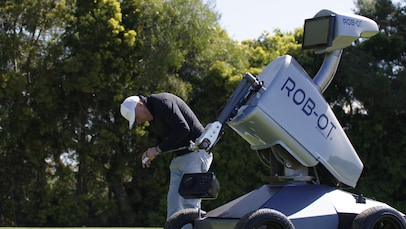 Golf Digest Logo How we test golf’s most common questions with a swing robot Our test
Golf Digest Logo How we test golf’s most common questions with a swing robot Our test
To better understand the importance of swinging faster vs. swinging more optimally, we tested 95 mph and 105 mph driver swings with a 10.5-degree driver using the Golf Laboratories swing robot—the same robot used in testing by equipment manufacturers as well as the USGA and R&A. We measured club and ball data using Foresight Sports’ GCQuad launch monitor.
With help from Golf Lab founder Gene Parente, we set the 95 mph swing to produce optimal launch conditions, which is golf-nerd speak for how the ball interacts with the clubface at impact and begins its flight. Whether the ball takes off high, low, with lots of spin or hardly any at all, that’s what we refer to as “launch conditions.” Here’s the ideal that we tested for a 95 mph driver swing:
- impact position 9 mm above the center of the face (the ideal location for distance)
- 1.2-degree upward angle of attack
- 13.4-degree launch angle
- 2,314 RPMs of spin
Each of these numbers create an optimal driver swing for someone swinging at 95 mph with a 10.5 driver.
What if you swung 10 mph faster but were not able to produce the same ideal launch conditions? In other words, your technique deteriorated as you increased clubhead speed. To test that example, we set the robot to swing at 105 mph but with these launch conditions:
- Impact position 15 mm below the center of the face
- 1.2-degree downward angle of attack
- 4.8-degree launch angle
- 3,549 RPMs of spin
This shot was hit low on the face, which decreases distance. The downward angle of attack, combined with this impact location, meant this ball launched significantly lower and with much more spin—both distance killers. It’s worth noting that the club path and face angles were nearly identical for each swing we tested.
What we found
Which ball traveled farther: The slower but more optimal swing, or the faster and less ideal swing?
The 95-mph swing produced a drive that traveled a total of 250.5 yards, while the 105-mph swing produced a shot that traveled a total of 245 yards—about five yards less than the slower swing.
Here are the numbers from the test.
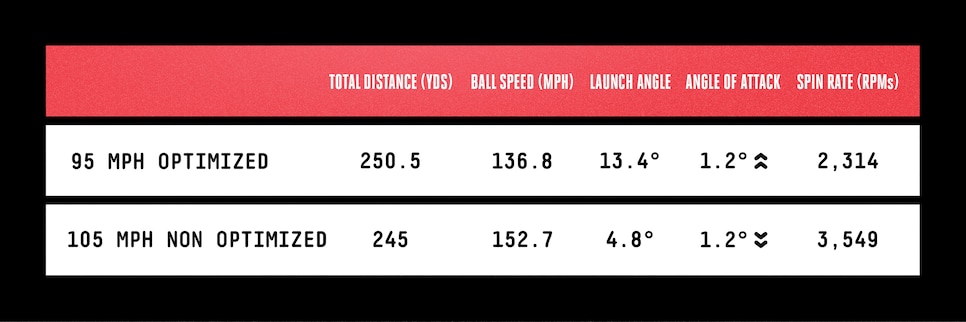 What it means
What it means
What’s fascinating is that the ball speed on the 105-mph swing was significantly greater (152.7 mph) than the slower swing (136.8 mph), but that faster ball speed produced a shorter drive. How is that possible?
Modern drivers and golf balls are designed to be launched in a very specific window to create the greatest distance. Generally speaking, to maximize distance, you want a slightly positive, or upward, angle of attack (think: hitting up on the ball) and an impact location just above the center of the face. That’s how you achieve the “high launch, low spin” optimal launch conditions.
MORE: To hit the ball farther, you need more ball speed, right? Not always
Without the proper angle of attack and impact location, however, launch numbers are thrown way off. While the faster swing produced a faster ball speed, that didn’t create greater distance because the ball launched too low with too little spin.
What it doesn’t mean
Let this be clear: Swinging faster while maintaining optimal launch conditions will absolutely hit the ball farther. What we’ve tested is if your launch conditions deteriorate as you begin to swing faster, perhaps because of a swing flaw that emerges.
We are not saying that you should strive to swing slower because there are no guarantees that your slower swing will produce these optimal numbers and that your faster swing will not. Rather, we demonstrate the importance of testing and monitoring your launch conditions to make sure that you’re maximizing distance. Improving these launch conditions can come from a variety of sources, including improving your swing mechanics and getting properly fit for a driver.
Verdict
Swinging faster is not always the solution to hit the ball farther. In our robot testing, optimized launch conditions with a slower swing speed helped hit the ball farther than a swing that was 10 mph faster but that had non-optimized conditions.
More Golf Digest MythBusters 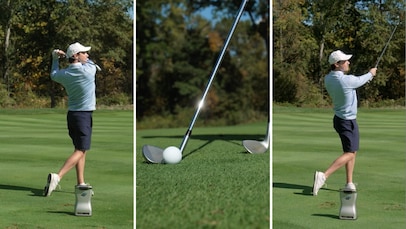 Golf Digest Logo Does taking more club actually help? What our test reveals
Golf Digest Logo Does taking more club actually help? What our test reveals 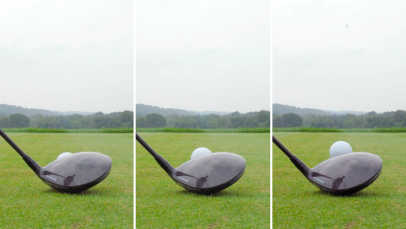 Golf Digest Logo Does a higher tee really produce more distance? What our test reveals
Golf Digest Logo Does a higher tee really produce more distance? What our test reveals 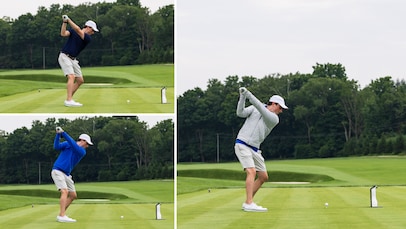 Golf Digest Logo Do layers of clothing slow down swing speed? Our test reveals surprising results
Golf Digest Logo Do layers of clothing slow down swing speed? Our test reveals surprising results
This article was originally published on golfdigest.com
